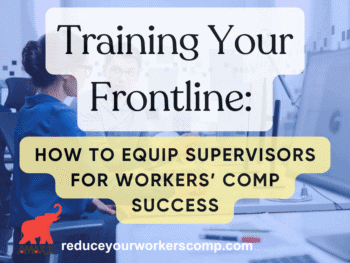
For example, a worker with a painkiller use disorder (like opioid painkillers) misses an average of six weeks of work each year. Workers with untreated substance use disorders often report having more than one employer in a year; this high turnover can cost employers more than $4,000 annually per employee with a substance use disorder.1
Click Link to Access Free PDF Download
“9-Element Blueprint To Create Your Workers’ Comp Employee Brochure”
Substance use disorders at work can be deadly. Ninety-five percent of all opioid overdoses occur in working-age adults, those between the ages of 18 – 64.2 Workplace overdose deaths have increased by 25% five years in a row.3
Ways to Prevent Opioid Misuse4
- Educate yourself, family, and friends. Understand risk factors, reasons opioids are prescribed, alternative treatments for pain relief, treatment options, ways to safely discard unused medications, and warning signs someone is suffering from a substance use disorder.
- Understand your healthcare plan. Many plans cover mental and behavioral health services. Participate in annual screenings with your healthcare provider. Have open discussions about alcohol and drug use.
- Consider alternative treatment modalities if you are suffering from pain; for example: massage, ice or heat therapy, non-opioid medications (including topical treatments, NSAIDs, and acetaminophen), acupuncture, aqua therapy.
- Know about your benefits, such as an employee assistance programs (EAP). This benefit is often underutilized and can help employees and/or their loved ones fight a substance use disorder. EAP may provide services such as: confidential counseling, access to medical treatment programs, over-the-phone consultations.
- Minimize stress, focus on self-care. Ensure you are getting enough sleep, eating properly, and exercising; consider meditation. Remember that support systems are important. If you are recovering from addiction, make groups such as NA or AA a priority.
- Get involved in community initiatives; encourage drug take-back programs.
- Employers should: Train supervisors and employees on ways to spot signs of drug misuse. Have strong company policies regarding alcohol and substance use. Promote the use of EAP and offer lunch-and-learn opportunities to educate their staff. Ensure the return-to-work program is robust and does not place workers at an increased risk of re-injury.
Signs of an Opioid Overdose
More than 130 people in the U.S. die every day from an opioid overdose. However, only 20% of Americans are confident that they can identify the signs of an overdose.5 Let’s change that statistic.
An opioid overdose occurs when the level of medication in a person’s system causes their breathing to significantly slow or stop entirely—this results in death if there is no medical intervention.
Signs of an overdose include:6
- Loss of consciousness or inability to respond/talk
- Lack of response to outside stimulus
- Limpness of the body
- Gurgling sounds or drooling
- Slow and shallow breathing or no breathing at all
- Vomiting
- Lighter skinned people may turn bluish purple
- Darker skinned people may turn grayish
- Clammy skin
- Fingernails and lips may turn blue or purplish black
If you suspect someone is overdosing: Stay with them and call (or have someone else call) 9-1-1. Try to keep them awake (ask them questions, talk loudly). Stimulate the person by rubbing your knuckles into their sternum. If they are unconscious, roll them on their side with their face turned to the side and monitor for vomiting (this is a recovery position).7 Wait until EMS arrives.
Many first responders and law enforcement agents now carry and dispense the opioid overdose antidote naloxone. All Medcor clinics are equipped with naloxone. Naloxone rapidly reverses an opioid overdose and can quickly restore normal breathing. This medication will work within 2-5 minutes and stops the effects of opioids for 30 to 90 minutes.8
This article is not intended to diagnose or treat any condition or to give medical advice. Always consult your primary care provider for healthcare instructions. External links are provided as references and do not indicate an endorsement by Medcor. External links are subject to other sites’ terms of use and privacy policies.
Article originally published at: https://www.medcor.com/opioids-work-and-overdoses/
Author Ashley Clay, MSPAS, PA-C, Medcor Provider. Medcor helps employers reduce the costs of workers’ compensation and general health care by providing injury triage services and operating worksite health and wellness clinics. Medcor’s services are available 24/7 nationwide for worksites of any size in any industry. Headquartered in McHenry, Illinois, the company operates 174 clinics and provides triage services to over 90,000 worksites across all 50 states and US territories. Medcor’s triage methods are covered by U.S. & foreign patents, including U.S. No. 7,668,733; 7,716,070; & 7,720,692; other patents pending. Medcor is privately held. Learn more at www.medcor.com.
1 National Safety Council, “Implications of Drug Use for Employers,” https://www.nsc.org/work-safety/safety-topics/drugs-at-work/costs-for-employers
2 National Safety Council, “Opioids: FAQs and Stats to Know,” https://www.nsc.org/Portals/0/Documents/RxDrugOverdoseDocuments/RxKit/2019/Basics/Opioids-FAQs-Stats.pdf?ver=2019-08-19-163443-803
3 National Safety Council, “How Opioids Impact Your Employees’ Safety and Your Bottom Line,” https://www.nsc.org/Portals/0/Documents/RxDrugOverdoseDocuments/RxKit/2019/Basics/How-opioids-impact-employees-safety-and-bottom-line-infographic.pdf?ver=2019-08-19-163443-600
4 National Safety Council, “Preventing Opioid Misuse in the Workplace,” https://www.nsc.org/Portals/0/Documents/RxDrugOverdoseDocuments/RxKit/2019/Basics/Preventing-Opioid-Misuse-in-the-Workplace.pdf?ver=2019-08-19-163444-197
5 “Opioids: FAQs and Stats to Know.”
6 Harm Reduction Coalition, “Recognizing Opioid Overdose,” https://harmreduction.org/issues/overdose-prevention/overview/overdose-basics/recognizing-opioid-overdose/
7 Harm Reduction Coalition, “Call for Help!,” https://harmreduction.org/issues/overdose-prevention/overview/overdose-basics/responding-to-opioid-overdose/call-for-help/
8 Alliance for Action, “Naloxone Facts,” https://allianceforaction.org/individuals/naloxone/
















